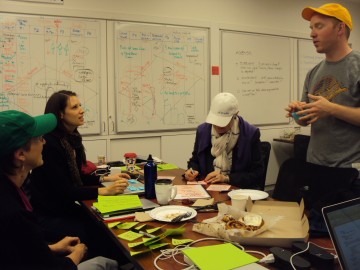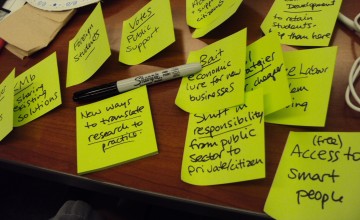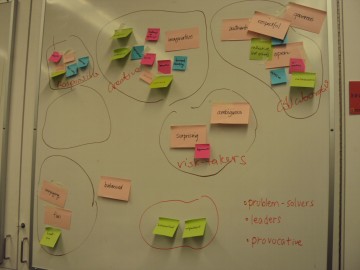Time really does fly. It has been a month since I have been working at the Sauder Studio. And I just thought I would write something about the learning experience here.

Putting on our "thinking caps"
So this Wednesday, we had a team-building day. And better still, our new MBA graduate Business and Development colleague, Chris, and I got to lead a two-hour session of the meeting. Frankly speaking, when we were assigned this opportunity, I thought we would just be going through the calendar, stating our work plans of the projects we will be doing, receiving confirmation from the group and then moving on. In short, I thought it was going to be a “one-way” meeting. But simply learning alongside Chris and taking a step back allowed me to think out of the box, and plan the meeting in a different way.
You see, amongst all my team members, I would say I am the one who really entered the Sauder d.studio with “a fresh set of eyes.” What I mean is that I came into the studio without knowing what design thinking is all about. I was bringing in a different perspective to the team, from the eyes of an individual who was clueless about design thinking or the Sauder d.studio. If there is one misconception I had about the studio, I thought it was all about technology. Rather, design thinking or the Sauder d. studio is about thinking creatively using the tools learnt, being less antsy about jumping into a solution (that’s something I am learning to practice), and collaborating with others to build on each other’s ideas.

Role-playing: A politician's ideas towards Sauder d.studio
Two of the design strategy tools that we lead and which stood out to me were ‘Role Playing’ and ‘Building our Brand Personality.’ Tell any BCOM class that we will be doing ‘Role Playing’, and trust me, you will see bewilderment written over our face. But this version of ‘Role Playing’ wasn’t really acting, rather, it was ‘thinking in someone else’s shoes.’ We were given different characters (such as professor, student, politician) of the Sauder d. studio, and ‘acting as those characters’, we answered two questions: What do I do? What do I need? With our answers, we grouped them into themes to answer the bigger question of “How do we create a world-class design studio?” I felt that this technique enabled us to take a step back in the profession we happen to be so entwined in and think from a different perspective.
On the other hand, ‘Building our Brand Personality’ gave us some freedom to write down characteristic traits that describe our Sauder d.studio brand. From there, we group these words into similar themes, and brainstormed personality traits that represent the Sauder d.studio. Sounds kind of confusing yeah? I’ll give you an example…
“The Sauder d.studio is passionate. We are more consultative than assertive.”
So, ‘passionate’ would be the personality trait, and ‘consultative’ and ‘assertive’ are the characteristic traits. You would continue to think of other personality traits, and adjectives to describe them. This tool would allow us to have a clearer sense of our brand.
Well, well, I hope I haven’t hurt your head in trying to explain these design strategy tools. I guess it will make more sense when you try them out! And I guess I will picking up more of these as my summer progresses.
